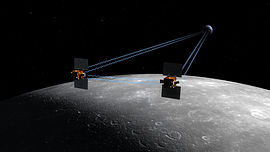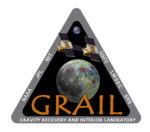- Gravity Recovery and Interior Laboratory
-
For other uses, see Grail (disambiguation).
Gravity Recovery and Interior Laboratory (GRAIL) 
Artist's interpretation of the GRAIL tandem spacecraft above the lunar surfaceOperator NASA / JPL Major contractors Lockheed Martin Space Systems
Massachusetts Institute of TechnologyMission type Orbiter Satellite of The Moon Orbital insertion date December 31, 2011 (GRAIL-A), January 1, 2012 (GRAIL-B) (planned) Launch date 2011-09-10, 13:08:52.775 UTC Launch vehicle Delta II 7920H-10 configuration (D-356) Launch site Space Launch Complex 17B
Cape Canaveral Air Force StationMission duration March 2012 - May 2012 (planned) COSPAR ID 2011-046 Homepage http://moon.mit.edu Mass 132.6 kg (292 lb) Power (Solar array / Li-ion battery) References: [1][2] 
GRAIL mission logoThe Gravity Recovery and Interior Laboratory (GRAIL) is an American lunar science mission in NASA's Discovery Program, which will use high-quality gravitational field mapping of the Moon to determine its interior structure. The two small spacecraft GRAIL A and GRAIL B were launched on 10 September 2011 aboard a single launch vehicle: the most-powerful configuration of a Delta II, the 7920H-10.[1][3][4] GRAIL A separated from the rocket about nine minutes after launch, GRAIL B followed about eight minutes later. They will arrive at their orbits around the Moon 24 hours apart.[5]
The science phase of the mission will last for 90 days. Following the science phase (or extended mission phase), a five-day decommissioning period is planned, after which the spacecraft will impact the lunar surface in about 40 days.[6] The gravity mapping technique is similar to that used by Gravity Recovery and Climate Experiment (GRACE), and the spacecraft design is based on XSS-11.[7]
Unlike the Apollo program missions, which took three days to reach the Moon, GRAIL will make use of a three- to four-month low-energy trans-lunar cruise via the Sun-Earth Lagrange point L1 to reduce fuel requirements, protect instruments and reduce the velocity of the two spacecraft at lunar arrival to help achieve the extremely low 50 km (31 mi) orbits with separation between the spacecraft (arriving 24 hours apart) of 175 to 225 km (109 to 140 mi).[8][9] The very tight tolerances in the flight plan leaves little room for error correction leading to a launch window lasting one second and providing only two launch opportunities per day.[10]
Maria Zuber of the Massachusetts Institute of Technology is GRAIL's principal investigator. The mission's team of expert scientists and engineers also includes former NASA astronaut Sally Ride, who will lead the mission's public outreach efforts. NASA's Jet Propulsion Laboratory manages the project. As of August 5, 2011, the program has cost US$496 million.[11]
Contents
Objectives
Each spacecraft transmits and receives telemetry from the other spacecraft and Earth-based facilities. By measuring the change in distance between the two spacecraft, the gravity field and geological structure of the Moon can be obtained. The gravitational field of the Moon will be mapped in unprecedented detail.[12]
Primary objectives
- Map the structure of the lunar crust and lithosphere
- Understand the asymmetric thermal evolution of the Moon
- Determine the subsurface structure of impact basins and the origin of lunar mascons
- Ascertain the temporal evolution of crustal brecciation and magmatism
- Constrain the deep interior structure of the Moon
- Place limits on the size of the Moon's inner core
The data collection phase of the mission will last 90 days, and will be followed by 12 months of data analysis.[12] Results will begin to become available about 30 days after the collection begins.[8] The knowledge acquired will aid understanding of the evolutionary history of the terrestrial planets.[8]
Instruments
- Ka band ranging assembly (KBR)
- Radio science beacon (RSB)
- Moon Knowledge Acquired by Middle school students (MoonKam).[13] Each MoonKAM system (one per spacecraft) consists of a digital video controller and four camera heads.[14]
Launch attempts
All times are in EDT (UTC-4).
Attempt Planned Result Turnaround Reason Decision point Weather go % Notes 1 8 Sep 2011, 8:37:06 am scrubbed[15] --- high level winds 8 Sep 2011, 8:30 am 40% A weather balloon was released minutes before the decision point to take the latest readings of upper level winds and Air Force weather reconnaissance aircraft were aloft beginning at 7 am. 2 8 Sep 2011, 9:16:12 am scrubbed[15] 0 days, 0 hours, 39 minutes high level winds 8 Sep 2011, 9:07 am 40% [10] Range was reconfigured for omni antennae instead of tracked ones to support 99 degree azimuth. 3 9 Sep 2011, 8:33:25 am abandoned[15] 0 days, 23 hours, 17 minutes rocket propulsion 40% An issue with the rocket's propulsion system was detected while the Delta 2 rocket was drained of fuel. 4 10 Sep 2011, 8:29:45 am scrubbed[15] 0 days, 23 hours, 56 minutes high level winds 10 Sep 2011, 8:21 am 60% 5 10 Sep 2011, 9:08:52 am Success[15] 0 days, 0 hours, 39 minutes Mission status
The two small spacecraft which compose GRAIL were launched on 10 September 2011.[1][15] GRAIL will make use of a three- to four-month low-energy trans-lunar cruise via the Sun-Earth Lagrange point L1 to reduce fuel requirements, protect instruments, and reduce the velocity of the two spacecraft at lunar arrival to help achieve the extremely low 50 km (31 mi) orbits with separation between the spacecraft (arriving 24 hours apart) of 175 to 225 km (109 to 140 mi).[8][9] The planned orbital insertion dates are December 31, 2011 (for GRAIL-A) and January 1, 2012 (for GRAIL-B).[15]
-
GRAIL awaits launch at Cape Canaveral Air Force Station.
-
Fire and smoke light up a blue sky as a United Launch Alliance Delta II Heavy rocket propels GRAIL into space.
References
- ^ a b c "Delta II Set to Launch NASA's GRAIL Mission". United Launch Alliance. 2011. http://www.ulalaunch.com/site/pages/Launch.shtml#/21/. Retrieved 2 September 2011.
- ^ "The GRAIL Mission: A Fact Sheet". Sally Ride Science. 2010. http://www.grailmoonkam.com/about/grail_fact_sheet. Retrieved 2010-04-15.
- ^ Delta II: The Industry Workhorse. United Launch Alliance. 2010. http://www.ulalaunch.com/site/docs/product_cards/DII_product_card.pdf. Retrieved 2 August 2011.
- ^ Grey Hautaluoma (10 December 2007). "New NASA Mission to Reveal Moon's Internal Structure and Evolution". NASA. http://www.nasa.gov/home/hqnews/2007/dec/HQ_07274_Grail_Mission.html. Retrieved 31 August 2011.
- ^ Moon-bound twin GRAIL spacecraft launch success
- ^ GRAIL web page. "Mission Design". MIT. http://moon.mit.edu/design.html. Retrieved 13 April 2011.
- ^ Taylor Dinerman (Monday, 31 December 2007). "Is XSS-11 the answer to America’s quest for Operationally Responsive Space?". The Space Review. http://www.thespacereview.com/article/1026/1. Retrieved 31 August 2011.
- ^ a b c d "Mission Overview". MIT. http://moon.mit.edu/overview.html. Retrieved 10 September 2011.
- ^ a b "Mission Design". NASA. http://solarsystem.nasa.gov/grail/missiondesign.cfm. Retrieved 10 September 2011.
- ^ a b Justin Ray (17 August 2011). "GRAIL Launch Window Chart". SpaceFlight Now. http://www.spaceflightnow.com/delta/d356/windows.html. Retrieved 9 September 2011.
- ^ Marcia Dunn, AP Aerospace Writer (Friday, 5 August 2011). "NASA Spacecraft Begins 5-Year Trip to Jupiter". Yahoo News. http://news.yahoo.com/nasa-spacecraft-begins-5-trip-jupiter-211124283.html. Retrieved 07 September 2011.
- ^ a b "About GRAIL". MIT. http://moon.mit.edu/index.html. Retrieved 2011-03-12.
- ^ "About GRAIL MoonKAM". Sally Ride Science. 2010. http://www.grailmoonkam.com/about. Retrieved 2010-04-15.
- ^ "GRAIL Launch Press Kit". NASA. http://solarsystem.nasa.gov/grail/docs/GRAIL%20launch%20press%20kit1.pdf. Retrieved 31 August 2011.
- ^ a b c d e f g Harwood, William. "NASA launches GRAIL lunar probes". CBS News. http://www.cbsnews.com/stories/2011/09/10/scitech/main20104282.shtml. Retrieved 11 September 2011.
External links
- MIT GRAIL Home Page
- NASA 360 New Worlds New Discoveries 2/2 Retrieved 6/3/2011.
- Behind The Scenes of My NASA GRAIL Experience – Day One (AM)
← 2010 · Orbital launches in 2011 Elektro-L No.1 | USA-224 | Kounotori 2 | Progress M-09M (Kedr) | Kosmos 2470 | USA-225 | Johannes Kepler | STS-133 (Leonardo) | Kosmos 2471 | Glory · Explorer-1 [Prime] · KySat-1 · Hermes | USA-226 | USA-227 | Soyuz TMA-21 | Compass-IGSO3 | USA-229 | Resourcesat-2 · YouthSat · X-Sat | Yahsat 1A · New Dawn | Progress M-10M | Meridian 4 | USA-230 | STS-134 (AMS-2 · ELC-3) | Telstar 14R | ST-2 · GSAT-8 | Soyuz TMA-02M | SAC-D | Rasad 1 | Zhongxing-10 | Progress M-11M | Kosmos 2472 | USA-231 | Shijian XI-03 | STS-135 (Raffaello · PSSC-2) | Tianlian I-02 | Globalstar M085 · Globalstar M088 · Globalstar M091 · Globalstar M085 · Globalstar M081 · Globalstar M089 | GSAT-12 | SES-3 · KazSat-2 | USA-232 | Spektr-R | Compass-IGSO4 | Shijian XI-02 | Juno | Astra 1N · BSAT-3c/JCSAT-110R | Paksat-1R | Hai Yang 2A | Sich 2 · NigeriaSat-2 · NigeriaSat-X · RASAT · EDUSAT · AprizeSat-5 · AprizeSat-6 · BPA-2 | Ekspress-AM4 | Shijian XI-04 | Progress M-12M | GRAIL-A · GRAIL-B | Zhongxing-1A | Kosmos 2473 | Arabsat 5C · SES-2 | IGS Optical 4 | Atlantic Bird 7 | TacSat-4 | Tiangong 1 | QuetzSat-1 | Kosmos 2474 | Intelsat 18 | Eutelsat W3C | Megha-Tropiques · SRMSAT · VesselSat-1 · Jugnu | ViaSat-1 | Galileo-IOV 1 · Galileo-IOV 2 | NPOESS Preparatory Project · Explorer-1' · RAX · M-Cubed · Dynamic Ionosphere CubeSat Experiment · AubieSat 1 | Progress M-13M · (Chibis-M) | Shenzhou 8 | Kosmos 2475 · Kosmos 2476 · Kosmos 2477 | Fobos-Grunt · Yinghuo-1 | Yaogan 12 · Tian Xun-1Payloads are separated by bullets ( · ), launches by pipes ( | ). Manned flights are indicated in bold text. Uncatalogued launch failures are listed in italics. Payloads deployed from other spacecraft are denoted in (brackets).Discovery Program Planned Comet Hopper (CHopper) · Titan Mare ExplorerActive Follow-on Completed Failed Robotic exploration of the Moon Programs Orbiters Planned Proposed Flybys Impactors Landers Rovers S. Return Cancelled See also - Moon
- Exploration of the Moon
- Colonization of the Moon
- Manned lunar spacecraft
- List of artificial objects on the Moon
- List of current and future lunar missions
- List of lunar probes
- Apollo
- CCCP manned lunar plan
Bold italics indicates active missionsCategories:- Discovery program
- 2011 in spaceflight
Wikimedia Foundation. 2010.






